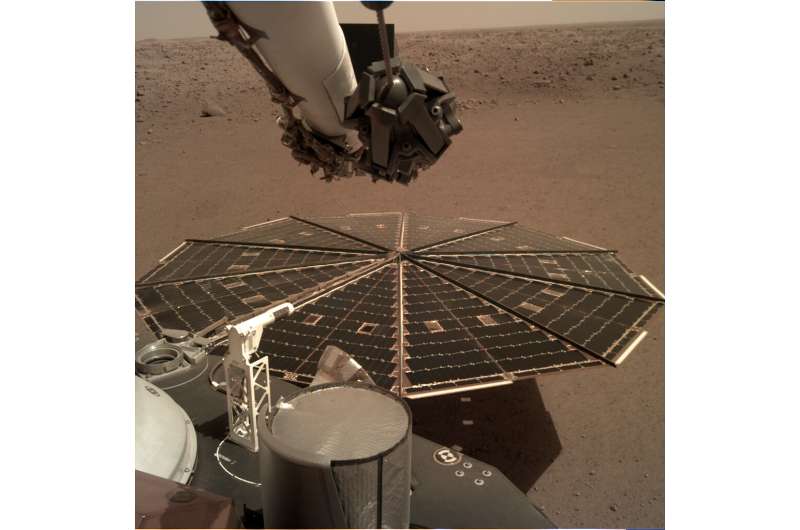

Covered in the red dust that sealed its fate, the NASA InSight lander is slowly shutting down, more than 250 million kilometers from home.
With its solar panels now obscured by the red planet’s debris, the four-year-old robot is running out of power. One by one, its instruments are being taken offline: its robotic arm moving into “retirement pose,” its seismometer likely to be turned off sometime in June.
Dr. Catherine Johnson, co-investigator on the InSight science team and professor in the department of earth, ocean and atmospheric sciences, discusses what the team discovered, what questions are left to answer, and just what will happen to the little lander that could.
What was the lander’s mission and what did it find?
This was the first outer space robot to study in-depth the inside of Mars: its crust, mantle, and core. Launched in 2018, it made measurements of ground movement (seismic data), weather (temperature, wind, pressure and even magnetic field), and accurately measured the planet’s rotation, all to help us figure out how rocky planets in our solar system formed. Unlike many other Mars robots, the InSight has been a stationary lander, because the seismometer needs to remain in one place to measure very tiny ground motions resulting from “marsquakes.”
We learned so much about the questions we set out to address, such as understanding the thickness of Mars’ crust, how big its metal core is, the planet’s interior structure, when and where marsquakes happen and how big they are.
I’ve been working on data from the magnetometer. We’ve learned how strongly magnetized the rocks beneath the landing site are, and that there are time variations in the planet’s magnetic field, probably related to magnetic fields generated by electric currents in the atmosphere or above by solar winds. We know for example, that similar to on Earth, there are variations in the magnetic field from day to night.
Is the lander really dead, or is it just sleeping?
The InSight lander will be sleeping, and it could wake up some time in the future. The instruments will be turned off and it will enter a mode where it’s no longer even awake in a way that we could talk to it routinely. But the operations team can put software in place such that if it were to regain power, by, say, the solar panels being cleared by a strong gust of wind, there would be a way for us to communicate with it, or the lander could message us.
I’ll be sad when it shuts down. You get quite attached to your robots. Anybody who has watched a Roomba go around the living room understands you can get attached to a robot! And, when you get to be part of something that is really difficult to do and make observations that are a first in some way, there’s some attachment.
The thing that is most difficult in some ways is that all the instruments that have been working are still working, they’re just isn’t enough power to keep them going. It would be wonderful to use these instruments that are working so well to take observations over many years.

What mysteries does Mars still have to offer?
We’ve seen that the occurrence of marsquakes appears to be seasonal in nature, and we don’t know why. We have been able to get data for close to two Mars years (every Mars year is about two Earth years), so we know it’s not just a fluke—we can see this pattern repeating, with more quakes at certain times of the Martian year. Why quakes occur in this way is still one of the biggest puzzles for us.
We’ve also noticed that there are fluctuations in the magnetic field that are minutes-long or even shorter. Some of these look like little waves in the magnetic field and we don’t know why they happen—is there also a seasonal dependence in their occurrence, are they all resulting from the same cause?
Hopefully, another mission will land somewhere else on Mars with same instrumentation as that on InSight so we can continue to explore the mysteries of Mars’ interior.
NASA’s InSight records monster quake on Mars
University of British Columbia
Citation:
NASA’s InSight lander: The lonely fate of a robot on Mars (2022, May 17)
retrieved 17 May 2022
from https://phys.org/news/2022-05-nasa-insight-lander-lonely-fate.html
This document is subject to copyright. Apart from any fair dealing for the purpose of private study or research, no
part may be reproduced without the written permission. The content is provided for information purposes only.

